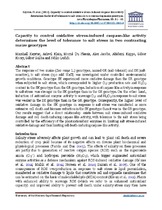Capacity to control oxidative stress-induced caspase-like activity determines the level of tolerance to salt stress in two contrasting maize genotypes
Date
2013Author
Keyster, Marshall
Klein, Ashwil
Du Plessis, Morné
Jacobs, Alex
Kappo, Abidemi
Kocsy, Gábor
Galiba, Gábor
Ludidi, Ndiko
Metadata
Show full item recordAbstract
The response of two maize (Zea mays L.) genotypes, named GR (salt-tolerant) and SK (salt-sensitive), to salt stress (150 mM NaCl) was investigated under controlled environmental growth conditions. Genotype SK experienced more oxidative damage than the GR genotype when subjected to salt stress, which corresponded to higher O2- production rate and H2O2 content in the SK genotype than the GR genotype. Induction of caspase-like activity in response to salt stress was stronger in the SK genotype than in the GR genotype. On the other hand, induction of antioxidant enzyme activity to scavenge O2- and H2O2 in response to salt stress was weaker in the SK genotype than in the GR genotype. Consequently, the higher level of oxidative damage in the SK genotype in response to salt stress was manifested as more extensive cell death and biomass reduction in the SK genotype than it was in the GR genotype. Our results suggest that a direct relationship exists between salt stress-induced oxidative damage and cell death-inducing caspase-like activity, with tolerance to the salt stress being controlled by the efficiency of the plantantioxidant enzymes in limiting salt stress-induced oxidative damage and thus limiting cell death-inducing caspase-like activity.

